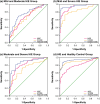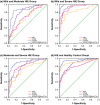Combined prediction of miR-210 and miR-374a for severity and prognosis of hypoxic-ischemic encephalopathy
- PMID: 29568675
- PMCID: PMC5853646
- DOI: 10.1002/brb3.835
Combined prediction of miR-210 and miR-374a for severity and prognosis of hypoxic-ischemic encephalopathy
Abstract
Background and aim: Hypoxic-ischemic encephalopathy (HIE) is a disorder featured by hypoxic and ischemic damages during the perinatal period and its high mortality (i.e., 15%-20%) could be partly attributed to late diagnosis. Therefore, miR-210 and miR-374a were investigated to find if they could improve the diagnostic values of S100B protein and neuron-specific enolase (NSE) for HIE.
Methods: Altogether 167 HIE newborns and 82 healthy newborns were recruited, and their blood were sampled for determining the levels of biomarkers. Specifically, S100B protein and NSE levels were detected based on the enzyme-linked immunosorbent assay (ELISA) kit, while the expressions of miR-210 and miR-374a were quantified by quantitative reverse transcription-polymerase chain reaction (qRT-PCR). Moreover, the receiver operating characteristic (ROC) curves were established to assess the diagnostic values of the above biomarkers for HIE. Finally, the correlation analysis between miR-210/miR-374 and Neonatal Behavioral Neurological Assessment (NBNA) scoring or Gesell intellectual development were also conducted.
Results: The levels of miR-210, miR-374a, S100B protein, and NSE were significantly distinct between HIE patients and healthy newborns (p < .05). Besides, miR-210 (rs = .573), miR-374a (rs = .651), NSE level (rs = -.622), and S100B level (rs = -.55) were all, respectively, correlated with NBNA scoring with statistical significance (p < .05). Furthermore, it was revealed that the combined diagnosis of miR-210, miR-374a, S100B protein, and NSE could obtain the highest accuracy regarding pairs of mild HIE versus moderate HIE (AUC = 0.898), moderate HIE versus severe HIE (AUC = 0.922), mild HIE versus severe HIE (AUC = 0.996), and HIE versus control (AUC = 0.960). More than that, the four molecules were also remarkably associated with Gesell intellectual development (p < .05).
Conclusion: MiR-210 and miR-374a could help to elevate the diagnostic value and prognostic prediction of S100B protein and NSE for HIE.
Keywords: combined diagnosis; hypoxic–ischemic encephalopathy; miR‐210; miR‐374a; prognosis; receiver operating characteristic curve.
Figures




Similar articles
-
Aberrant expression of miR-199a in newborns with hypoxic-ischemic encephalopathy and its diagnostic and prognostic significance when combined with S100B and NSE.Acta Neurol Belg. 2021 Jun;121(3):707-714. doi: 10.1007/s13760-020-01408-0. Epub 2020 Jun 12. Acta Neurol Belg. 2021. PMID: 32533551
-
Evaluation of urinary S100B protein level and lactate/creatinine ratio for early diagnosis and prognostic prediction of neonatal hypoxic-ischemic encephalopathy.Neonatology. 2010;97(1):41-4. doi: 10.1159/000227292. Epub 2009 Jul 7. Neonatology. 2010. PMID: 19590245
-
Relevance of urinary S100B protein levels as a short-term prognostic biomarker in asphyxiated infants treated with hypothermia.Medicine (Baltimore). 2017 Nov;96(44):e8453. doi: 10.1097/MD.0000000000008453. Medicine (Baltimore). 2017. PMID: 29095291 Free PMC article.
-
Neonatal hypoxic ischemic encephalopathy-related biomarkers in serum and cerebrospinal fluid.Clin Chim Acta. 2015 Oct 23;450:282-97. doi: 10.1016/j.cca.2015.08.021. Epub 2015 Aug 28. Clin Chim Acta. 2015. PMID: 26320853 Review.
-
Diagnostic and Prognostic Values of S100B versus Neuron Specific Enolase for Traumatic Brain Injury; a Systematic Review and Meta-analysis.Arch Acad Emerg Med. 2024 Feb 18;12(1):e29. doi: 10.22037/aaem.v12i1.2222. eCollection 2024. Arch Acad Emerg Med. 2024. PMID: 38572218 Free PMC article. Review.
Cited by
-
miR-374 family is a key regulator of chronic primary pain onset.Pain Rep. 2024 Oct 16;9(6):e1199. doi: 10.1097/PR9.0000000000001199. eCollection 2024 Dec. Pain Rep. 2024. PMID: 39430682 Free PMC article.
-
The latest progress on miR-374 and its functional implications in physiological and pathological processes.J Cell Mol Med. 2019 May;23(5):3063-3076. doi: 10.1111/jcmm.14219. Epub 2019 Feb 17. J Cell Mol Med. 2019. PMID: 30772950 Free PMC article. Review.
-
Temporally Altered miRNA Expression in a Piglet Model of Hypoxic Ischemic Brain Injury.Mol Neurobiol. 2020 Oct;57(10):4322-4344. doi: 10.1007/s12035-020-02018-w. Epub 2020 Jul 27. Mol Neurobiol. 2020. PMID: 32720074 Free PMC article.
-
Role of Sirtuin-1 in Neonatal Hypoxic-Ischemic Encephalopathy and Its Underlying Mechanism.Med Sci Monit. 2020 Aug 22;26:e924544. doi: 10.12659/MSM.924544. Med Sci Monit. 2020. PMID: 32826847 Free PMC article.
-
Neuronal let-7b-5p acts through the Hippo-YAP pathway in neonatal encephalopathy.Commun Biol. 2021 Sep 30;4(1):1143. doi: 10.1038/s42003-021-02672-3. Commun Biol. 2021. PMID: 34593980 Free PMC article.
References
-
- Azuma, J. , Nabatame, S. , Nakano, S. , Iwatani, Y. , Kitai, Y. , Tominaga, K. , … Ozono, K. (2015). Prognostic factors for acute encephalopathy with bright tree appearance. Brain & Development, 37(2), 191–199. - PubMed
-
- Chen, H. (2004). Exploration the diagnostic criteria for neonatal hypoxic‐ischemic encephalopathy. Journal of Clinical Pediatrics, 22(11), 712–713.
-
- Chen, X. W. , & Yu, R. J. (2004). Diagnose and treatment for neonatal hypoxic‐ischemic encephalopathy. Chinese Journal of Pediatrics, 42(12), 940–941. - PubMed
-
- Cowan, F. , Rutherford, M. , Groenendaal, F. , Eken, P. , Mercuri, E. , Bydder, G. M. , … de Vries, L. S. (2003). Origin and timing of brain lesions in term infants with neonatal encephalopathy. Lancet, 361(9359), 736–742. - PubMed
MeSH terms
Substances
LinkOut - more resources
Full Text Sources
Other Literature Sources
Miscellaneous

